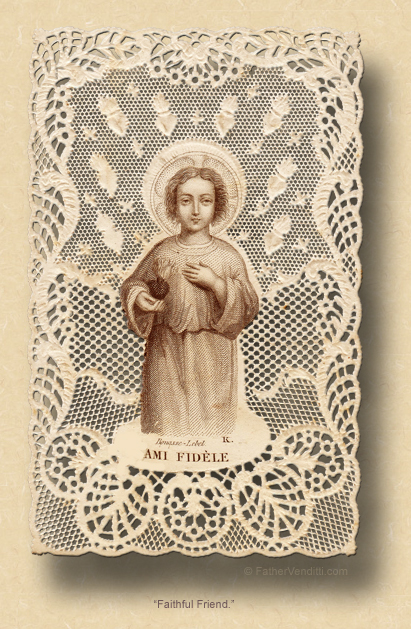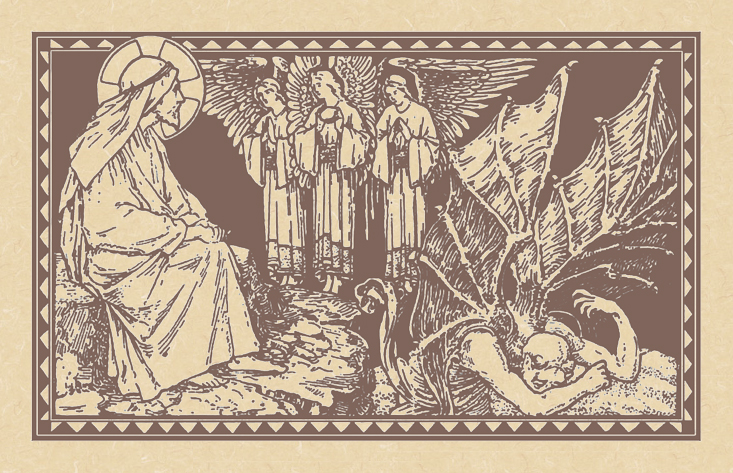Like Unto His Brethren.
In the United States:
The Fifth Day after the Octave of the Nativity; or, the Memorial of Saint André Bessette, Religious.*
Lessons from the feria, according to the ordinary form of the Roman Rite:
• I John 5: 5-13.
• Psalm 147: 12-15, 19-20.
• Luke 3: 23-38.
[or, Mark 1: 7-11.]
[or, Luke 3: 23, 31-34, 36, 38.]
|
When a Mass for the Memorial is taken, lessons from the feria as above, or any lessons from the common of Holy Men & Women for Religious.
|
|
Outside the United States:
The Solemnity of the Epiphany of the Lord.**
Lessons from the proper, according to the ordinary form of the Roman Rite:
• Isaiah 60: 1-6.
• Psalm 72: 1-2, 7-8, 10-13.
• Ephesians 3: 2-3, 5-6.
• Matthew 2: 1-12.
|
The First Class Feast of the Epiphany of the Lord.**
Lessons from the proper, according to the extraordinary form of the Roman Rite:
• Isaiah 60: 1-6.
• [Gradual] Isaiah 60: 6, 1.
• Matthew 2: 1-12.
The Solemn Holy Day of the Theophany of Our Lord, God & Savior Jesus Christ.**
Lessons from the menaion, according to the Ruthenian recension of the Byzantine Rite, at the Vigil Divine Liturgy of St. Basil:
• Genesis 1: 1-13.
• Exodus 14: 15-18, 21-23, 27-29.
• Exodus 15: 22--16: 1.
• Joshua 3: 7-8, 15-17.
• II (IV) Kings 2: 6-14.
• II (IV) Kings 5: 9-14.
• Isaiah 1: 16-20.
• Genesis 32: 1-10.
• Exodus 2: 5-10.
• Judges 6: 36-40.
• I (III) Kings 18: 30-39.
• II (IV) Kings 2: 19-22.
• Isaiah 49: 8-15.
• I Corinthians 9: 19-27.
• Luke 3: 1-18.
…and, at the Divine Liturgy of St. John Chrysostom on the day:
• Titus 2: 11-14.
• Matthew 3: 13-17.
…and, at the Great Blessing of Water:***
• Isaiah 35: 1-10.
• Isaiah 55: 1-13.
• Isaiah 12: 3-6.
• I Corinthians 10: 1-4.
• Mark 1: 9-11.
FatherVenditti.com
|
 8:36 AM 1/6/2017 — Our First Fridays are always dedicated to the Most Sacred Heart of our Lord and, as is our custom, we will expose the Blessed Sacrament after our Postcommunion Prayer; and, to keep this appropriate within the season, we’ll pray together the Litany of the Infant Jesus. The rest of the Holy Hour will be yours to converse with our Lord, or make use of the confessional, or both, and we’ll have Benediction at one thirty. 8:36 AM 1/6/2017 — Our First Fridays are always dedicated to the Most Sacred Heart of our Lord and, as is our custom, we will expose the Blessed Sacrament after our Postcommunion Prayer; and, to keep this appropriate within the season, we’ll pray together the Litany of the Infant Jesus. The rest of the Holy Hour will be yours to converse with our Lord, or make use of the confessional, or both, and we’ll have Benediction at one thirty.
The Missal provides us with two options for our Gospel lesson today—actually, three if you count that one of them is offered in both a long and a short version—and I’m guessing I’m the only priest in the world who chose to read to you Saint Luke’s ponderous genealogy, rather than Mark’s much more manageable and familiar account of our Lord’s baptism. It was just before Christmas that we heard Matthew’s genealogy of our Lord, which is very different. Matthew wrote his Gospel to converts from Judaism, so he’s only interested in showing how Jesus fulfilled the requirements of the prophets, proving that he is descended from Abraham and of the royal line of David. But our good friend Luke, whom we’ve spent so much time talking about this past year, was not a Jew, he was a Greek; nor did he write his Gospel for Jews. His genealogy stresses not the legal or religious aspects of our Lord’s human origins, but his purely human ones, and we read it today because it is a clear testimony to the reality of the incarnation.
We have to presume that the two evangelists had different sources in front of them when they wrote their genealogies since, from David through to Joseph, the foster-father of our Lord, only two names agree between them. But that’s not important; neither of them is interested in providing actual biographical data. Luke, you’ll remember, is both a poet and a psychiatrist, and he feels compelled to explain for his pagan readers what surely must have been a difficult concept for them: the idea that a God could actually want to temporarily abandon His divinity and become one of His own creatures, for no other reason than to save them from themselves.
That’s why this Gospel lesson is given to us to read on this Second Friday after Christmas. The incarnation is real, not just a puppet show. For over thirty years before He appears before John to be baptized and begin His work, he had experienced the poverty and insecurity, the peace and happiness of home life in Nazareth. He learned a trade from His father, and the faith from His Mother. He knew the heartbreak of having to say goodbye to that humble home in order to begin the work which He knew would take Him all over the Holy Land and end in His death.
Our Gospel lesson today ends at the conclusion of chapter three, and if we were to continue reading into chapter four, we would find our Blessed Lord led into the desert to be tempted, proving beyond any doubt, as the Letter to the Hebrews so wisely states, that Jesus is
…like unto His brethren, that He might be a merciful and faithful High Priest in things pertaining to God, to make reconciliation for the sins of the people. For in that He Himself hath suffered, being tempted, He is able to succor those who are tempted … For we do not have a High Priest who cannot be touched with the feelings of our infirmities, but was in all points tempted as we are, yet without sin. Let us therefore come boldly unto the throne of grace, that we may obtain mercy and find grace to help in time of need (Heb. 2: 17-18; 4: 15-16 KJ21).

* André Bessette (1845-1937) was born near Quebec, was orphaned at the age of twelve, spent four years in the US as a mill worker, then entered the Congregation of the Holy Cross in Montréal where, for over forty years, he fostered devotion to our Lord's foster father, particularly among the poor and sick. He built a shrine to St. Joseph in Montréal which, after his death, grew into a great basilica. He died in 1937 at the age of 91; more than a million people came to pay their respects.
** The Epiphany among the Traditions:
In the extraordinary form of the Roman Rite, the First Class Feast of the Epiphany, always celebrated on January 6th, commemorates three events in the life of our Blessed Lord: His manifestation to the gentiles in the visit of the Magi, His manifestation as the co-eternal Son of God in His baptism by John, and His manifestation as God Incarnate in the miracle at the wedding at Cana (this coming Sunday, make note of the woodcut print serving as the top image for that page, taken from an edition of the Missal of St. John XXIII, displaying all three events together). While the Epiphany is not officially followed by an octave, it does have a sort of octave day, January 13th, which carries the title of the Baptism of the Lord, and appears to be a second commemoration of that event; but, the Mass and office of that day are almost identical to that of the Epiphany and, should it fall on a Sunday, it is completely displaced by the Feast of the Holy Family.
In the ordinary form of the Roman Rite, the Solemnity of the Epiphany, celebrated on January 6th on the universal calendar and on the Sunday following the Octave in the United States, commemorates only the visit of the Magi, with His baptism commemorated on the following Sunday (or, as in the case this year, this coming Monday, since there is no available Sunday), which is the Feast of the Baptism of the Lord, after which the season of Ordinary Time begins. The Gospel of the Wedding at Cana is read on January 7th should that day fall before the Epiphany; otherwise, it is not commemorated until the Second Sunday of Ordinary Time, and then only on every third year, when the lessons of the tertiary dominica are read.
In the Byzantine Rite, the Solemn Holy Day of the Theophany, always celebrated on January 6th, commemorates only the Baptism of the Lord, and thus corresponds to the feast of that name in the Roman Rite rather than to the Epiphany, with there being no specific commemoration of the visit of the Magi apart from Christmas Day. The Wedding at Cana is not commemorated in this season, but first appears in the Divine Liturgy for the Second Monday of Pascha (Easter).
*** In the Ruthenian recension, water is traditionally blessed twice on Theophany. The first blessing, taking place following the Vigil Divine Liturgy of Saint Basil, is of the "Jordan Water" which is kept in church and used for baptisms. The second, the "Great Blessing of Water," takes place following the Divine Liturgy of Saint John Chrysostom, usually at the local river or other natural body of water, with the faithful then collecting the water from that source to take to their homes. The Typicon of the Ruthenian Metropolia of the USA, however, indicates that water may be blessed "whenever the faithful can best attend," using the formula of the Great Blessing of Water. When this is done in church following the Divine Liturgy, it replaces the blessing of the Jordan Water per se, and the lessons indicated for this service are usually omitted; this water is then distributed to the faithful.
|

